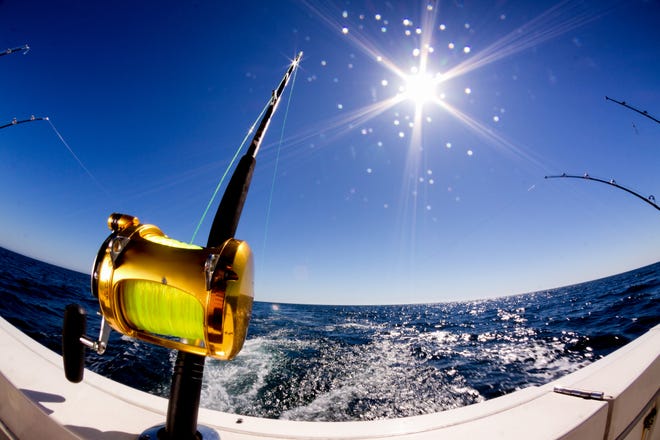On the Hook: Breaking point

This article’s subtle lesson deals with environmental impact. It’s story is hidden at the start but develops as we deal with one of the sport’s impact pieces of equipment, fishing line.
More:On the Hook: Fishing ethics of the next generation
I may be a member of a small group of fishing professionals who see the new “advancement” of synthetic braided line as harmful to the interface with the marine environment. Up to modern times almost all fishing lines used, especially in the salt water, were labeled as monofilament, which aptly described line strung from a ribbon of nylon, constructed in a myriad of strengths which allowed anglers a chance to sportingly select well engineered strengths to meet the sporting edge (i.e. you use light breakable line for smaller species).
More:Fishingcast: Conditions for May 8-14
Monofilament had elasticity to it. The line would stretch when a fish took the bait and it was breakable. The advertised weight off the line was accurate, too much drag set on the reel would cause the line to snap and could break off a catch purposely at the swivel by a reset of the drag. Think of an undersized snook getting wrapped around a mangrove branch.
Led by fishing tackle developers, then came the introduction of lines made of Dacron and beyond where you could feel the smallest bump on the line (a plus) but the breaking strengths were elevated because of the construction but you couldn’t cut the line or break it off on one of those tree limbs or cut it with the sharpest of fishing tools.
And so, we have the participants in the issue, mono or braid. And we have our article’s main player, an angler from Eastern Europe by the name of Hans, as our charter customer a few months back. He’s landlocked back home but vents his passion for fishing by working very “fishy” locations, like Canada, Bermuda and the Florida Keys often. In fact, he had just fished Key Largo and tarpon under the bridge and claimed it was “wunderbar.” We were his first stop as he worked his way west.
More:Gardening: The fertilizer deadline nears
We had gone over the of our trip at the booking phone contact and he made it clear he was focused here in SW Florida on the redfish and he wanted to use his own equipment. Upon inquiry, he admitted it was a medium action spinning rod armed with Fireline Braided Line with 20# test that he further admitted was much stronger.
I went off on my spiel about braided line and how it didn’t match up with the nature of the backwaters with all the fauna and mangrove trees. He just brushed the caution off as we pulled out of the marina.
The tide was rolling in and was forecast for a high midday, so we headed north to reach Upper Addison Bay mid-morning. We started working the shallow edges along the mangrove shoreline and Hans was missing his target spots with some rather atrocious short casts. He admitted he was a much better long caster and requested that we move off the edges. We complied and ended up about 30 yards off the mangrove edges. Here he’d have to drop his rig right on target 25-30 yards away; tough job.
But he loaded up and let fly. His cast was vigorous to say the least and his cast arched well past his intended target, a current edge, and landed with a rustled thud deep into a clump of mangrove trees. You see the braided line well up onto a clump of dense undergrowth.
Visibly upset with his situation, he moved to the bow and tried lining up straight on and pulled and pulled; nothing! He then wrapped the braid around his gloved hand and yanked harder.
Birds were scattering everywhere as he continued yanking and he was pulling the boat into the edges of the mangrove forest and he was screaming words I couldn’t even understand.
“Captain, We’ll have to cut the line!”
“Can’t cut the line at the rod tip, Hans, that leaves 25 yards of line dangling in that clump of trees which is a potentially fatal hazard for the seabirds”
“So, what do we do, Captain.”
“I’ll pull the anchor and you stand up on the bow and we’ll try to dislodge the rig”. We moved
Forward until were in two feet of water. He finally cut the braid after another struggle about 6 feet short of the swivel.
As we backed out Hans was noticeably upset. When I asked what was wrong he went into a rant about losing thirty minutes of charter time. Further he vented his dismay with “A seabird injured on a hank of fishing line is a certain rare occurrence, indeed, summed up his feeling and displeasure.
From the on you could feel the strained relations between us. But as fate would have it we did latch onto a nice redfish for him. He totally dismissed the problem with the unbreakable braided line.
As we pulled back into the dock at the marina, there were three dock hands trying to secure a pelican that was obviously in distress with a very visible “hank” of braided line wrapped around it’s beak with the lure embedded in its wing. The dock hands were in full struggle to help the pelican.
When finally, free the pelican took off and I handed him his fillets and making eye contact we shook hands and Hans uttered “I see now.”
More:On the Hook: Awaited change of seasons arrives
Capt. Bill Walsh owns a charter fishing business and holds a U.S. Coast Guard license. Send comments to dawnpatrolmarco@cs.com.